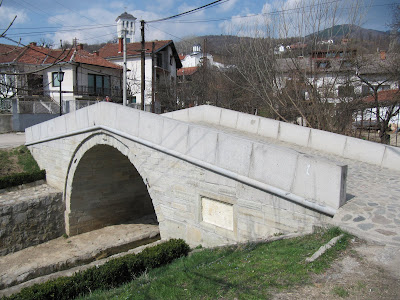Vranje is a town in Southern Serbia with around 70,000 inhabitants. Like Nis and the rest of Central-Southern Serbian it was ruled by the Ottoman Empire from the 1300s to 1800s and as such it has Turkish influences in architecture, language, food, and culture.
This first picture doesn't do it justice but there were a lot a lot of people out and about last Saturday and Sunday when we visited. Most of these people were enjoying the cafe scene and drinking coffee or tea with pals, a part of the culture in all of Serbia but even more so in the south. When we were in Novi Sad (Northern Serbia) there would hardly be anyone in the city center on Saturday and especially Sunday. The other towns and villages I visited in the north were the same, people kept to themselves and their homes on weekends. In Southern Serbia, including in Nis, people are always out with friends during the weekend. Our guide was a native, born and raised, and we talked about the differences between Southern Serbia and Vojvodina autonomous province (Northern Serbia) which was ruled by the Austro-Hungarian Empire and has a culture more akin to Western Europe. She said most people from Southern Serbia don't care for the Northern attitude. I'll admit people from Novi Sad and Northern Serbia had more of a rich, Western vibe and they tended to think that Vojvodina was pulled down by the rest of Serbia. In a sense it is because the industries and economy of Vojvodina are stronger than other parts of Serbia. But the Southerners have more of a laid back, humbled vibe and they don't like the more uptight nature of Vojvodina and the rest of Western Europe. Gordana, our guide, told us how people in Vranje are always in each other's business and no one keeps to themself like they do in the north which explains why everyone's eager to relax and enjoy each other on weekends and not simply stay at home. Gordana waved, joked, and gossiped with at least a dozen people during our walking tour of the town which helped illustrate this point.

The Belo most ili most ljubavi (white bridge or lovers bridge) dates back to the Turkish occupation in the mid-19th century and is a symbol for Vranje, featured on the Vranje coat of arms. The legend goes that a Muslim girl fell in forbidden love with a Serb and when the father found out he tried to kill the Serb but predictably killed his own daughter when she protected him (Serb lover). Then Serb boy killed himself. Romeo and Juliet roles reversed.

The Muslim father made the bridge in memory of his daughter and carved this message in Arabic but according to our guide no one knows what it says. When we suggested they try to take a picture of it and post it on the internet to try to get a translation she sort of just shrugged and sighed it off with a "Pa zasto?" (but why). After seven months I can confirm this is a very typical Serb response. It's not that she's lazy but she has no desire to figure it out and she's content with knowing it has something to do with legendary love.

We stayed in a hostel atop a mountain meant for skiers when there's natural snow. It took about 75 minutes to drive or rather safari our way up the mountain, half the time on rundown roads and the other half on a dirt path. Quite a fun trip in both directions.


No comments:
Post a Comment